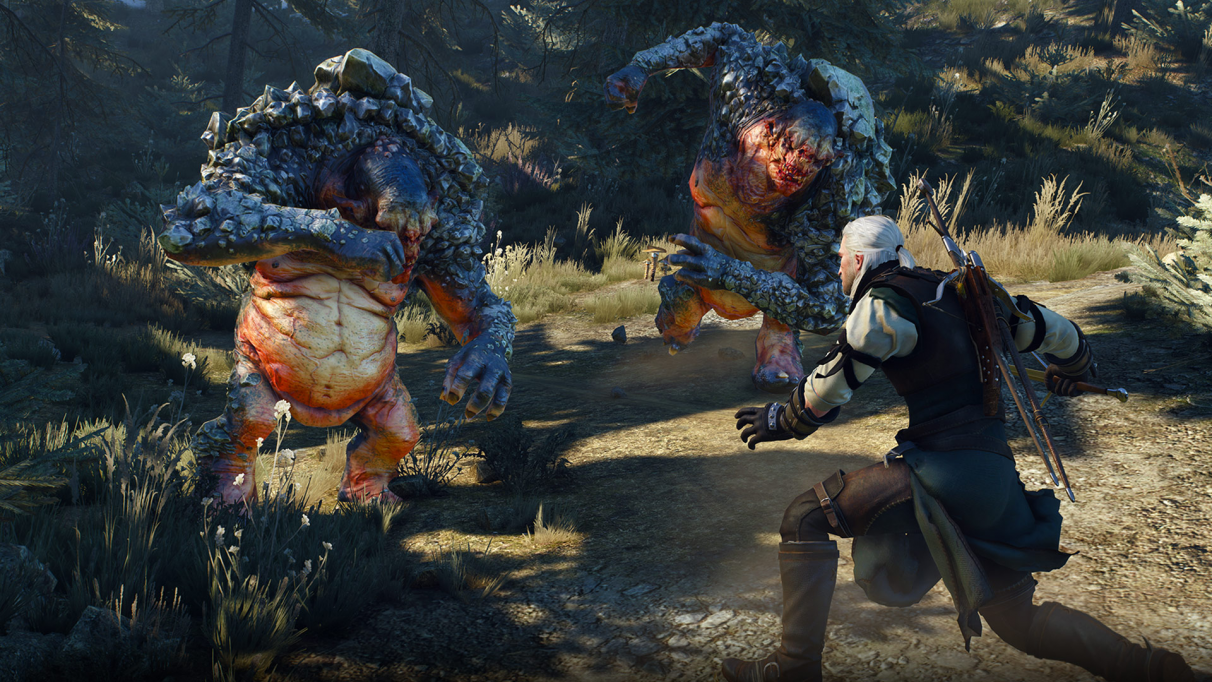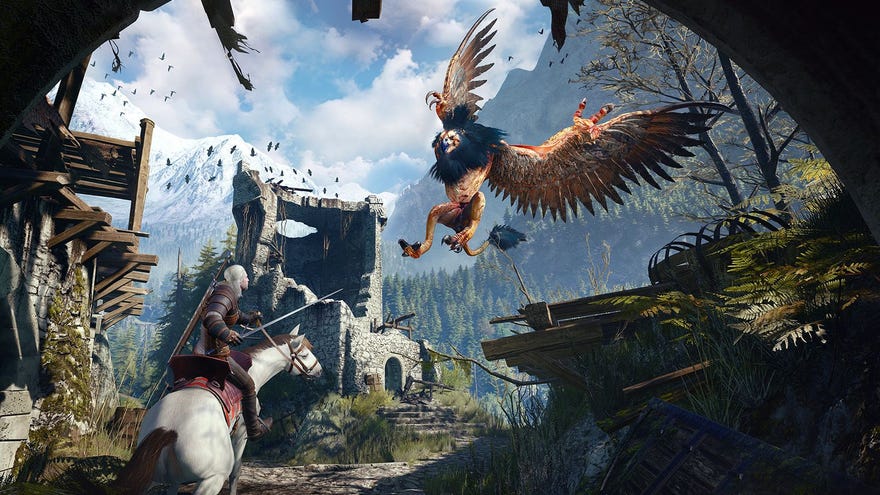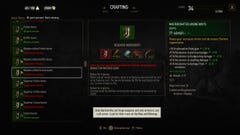The Witcher 3 combat tips: How to beat Golems, Wraiths, and all other enemies
Use these Witcher 3 combat tips to make Geralt an unstoppable force
Looking to upgrade your Witcher 3 combat skills? Whether you're brand new to The Witcher 3: Wild Hunt or have jumped back in courtesy of the next-gen upgrade, odds are you'll benefit from a quick combat tutorial. Combat in The Witcher 3 is a beast of two natures. At its best, it is elegant and satisfying, and rewards careful preparation. At its worst, it's like banging your head against a wall.
Don't worry though, because below we've compiled our best Witcher 3 combat tips to help you achieve the former and steer clear of the latter!
The Witcher 3 combat tips
- Understanding The Witcher 3 HUD
- Take care of your weapons
- Synergise your talents and your mutagens
- Dodge, Roll, and Parry
- How to prepare yourself for battle
- Use your crossbow for flying/underwater enemies
- Prioritise upgrading your Fast Attack
- Know when you're outmatched
- When to Quen
- When to Axii
- When to Igni
- When to Aard
- When to Yrden
The Witcher 3 has an impressively versatile combat system. It allows you to dive right in, swinging and blocking with instinct and abandon, but forces you to transition later on into a mindset of deliberation and grace - or suffer the consequences.
I've tried to boil down our Witcher 3 combat tips into a handful of understandable and practical elements, so by the end you'll hopefully have a much fuller knowledge of how to defeat almost any foe you come across in your travels across the Continent.

Understanding The Witcher 3 HUD
Okay, first off: I want you to raise your hand if you don't know what every single element of the combat HUD in The Witcher 3 means.
That's what I thought.
Don't worry, it took me a while to figure out and internalise all these different elements too. Just spend as much time as you need studying the helpful diagram above, and once we're ready, let's just move on. Cool? Cool.
Take care of your weapons
One of the most painful combat sins I see newer Witcher 3 players commit is the sin of not taking good care of your weapons. Armor too, now I think about it. You owe it to grizzled ol' Geralt to supply him with the very best tools you can find for carving up your foes.
That means doing two things. First: loot carefully, periodically carry out some inventory management, and make sure Geralt is equipped with the very best swords and armor available. Second: repair your goddamn equipment. Repair Kits are not hard to come by, but even if you're fresh out, just head to the nearest blacksmith's and get all those percentages up to 100. Please, I'm begging you.
Synergise your talents and your mutagens
Another aspect of your character that you need to stay on top of if you want to maximise your death-dealing efficiency is your talents and mutagens. This may be apparent to some, but there are two essential facts you need to know about the character panel:
- Spending a skill point to unlock a new talent doesn't mean you automatically start to benefit from it. You also have to equip the talent in one of the slots on the right half of the Character screen.
- Mutagens can be equipped in the edge slots of the Character screen, and a Mutagen's bonus is multiplied by the number of same-colour talents adjacent to them. So a red mutagen that provides a base +5% to attack power will be upgrade to 10%/15%/20% with 1/2/3 red talents placed next to it.
The lesson? Make sure not only that you have the right mutagens and talents equipped, but also that you position them correctly to get the very best synergies out of them.

Dodge, Roll, and Parry
Now let's get into the combat itself, and what better place to start than the methods of avoiding damage? Let's go over them one by one:
- Parry: hold right-click (by default) to block with your sword. This will reduce or completely negate damage from most light attacks, but against heavy attacks you will be stunned if you attempt to parry.
- Counterattack: this is when you perfectly time your parry by right-clicking just as the attack lands. Again, if you attempt to use this against a heavy attack you'll be stunned, but otherwise it allows you to quickly recover ready for a counter attack, while knocking your opponent off-balance and opening them up for your attack.
- Dodge: tap Alt (by default) and you will dodge in the direction you're moving. This is your bread-and-butter damage avoidance technique, and it's your best defence against heavy attacks.
- Roll: tap Space (by default) to roll in the direction you're moving. This costs you more in energy and recovery time than dodging, but it's your best bet for avoiding big charge attacks and the like, and it's the fastest way to put distance between yourself and the enemy.
In general, you should use counterattacks against humans, and dodges/rolls against monsters. There are exceptions; for example, spearmen and heavy axe-wielding soldiers can stun you with their attacks if you block them, so you should use dodges instead in this instance. And smaller swarmer enemies like Nekkers and Drowners can be parried without issue.
But the guideline is: counter human attacks and dodge monster attacks.
How to prepare yourself for battle
Okay: so you know when to dodge, roll, and counterattack. Trouble is, you're still getting your ass handed to you. The solution? Prepare carefully.
No, not the Rimworld mod. What I mean is you need to make use of all the other mechanics in The Witcher 3 that directly affect your chances of survival: potions, oils, and bombs.
- Potions are crafted from monster parts and herbs (for the most part), and when imbibed they will give you some sort of significant benefit for a short time. But they'll also raise your toxicity (see the HUD diagram above!), and if you breach 90% toxicity you'll overdose and start to take health damage.
- Decoctions are like potions, but stronger and more toxic.
- Oils are like potions and decoctions, but they're for coating your blade. Using the right oil will give you a significant damage bonus against monsters of a certain type - for example, beasts, or elementa.
- Bombs are crafted similarly to potions and oils, but they can be thrown at enemies, and enemies generally don't like what ensues. Bombs can also be dropped into Monster Nests to destroy them.
Of these, I'd say the first element to look at if you want to defeat an enemy that's been giving you trouble is the oils. Coating your blade with the right oil will shorten a fight significantly with a lovely damage boost per hit. But it depends on the issue. Decoctions can give you some amazing powers and enhancements for a time, which can often turn the tides of even the deadliest battle.
The other thing worth bearing mind is this: if you're doing a quest that involves taking on a certain challenging enemy, chances are the level designers have placed the herbs you need not at all far from the location of the fight. Where there's werewolves, there's wolfsbane.

Use your Crossbow for flying/underwater enemies
If you've completed the prologue, you'll probably already be used to the idea of shooting flying things like Griffins out of the sky with your little pew-pew crossbow. The real revelation here is this: there's a huge damage multiplier if you use the crossbow against underwater enemies such as Drowners (or they have reduced health when underwater - either way, it amounts to the same thing).
For so long I just avoided underwater Drowners as I didn't know how to deal with them. I wish I'd had the wherewithal to use my crossbow. Unless you're incredibly underlevelled relative to your enemies, you'll kill a Drowner in a single shot.
Prioritise upgrading your Fast Attack
Heavy attacks are fun and useful at times, but fast attacks will always be the most time-efficient means of dealing as much damage as possible.
So, the first thing you should upgrade when it comes to choosing talents should always be Muscle Memory. Not only will you be hitting for +25% damage by the time you've hit level 6, but you'll also be gaining Adrenaline points faster, which again will dramatically boost your damage.
Know when you're outmatched
If you see an enemy with a much higher level than you, it's best to steer well clear. I'm not saying you can't beat them if you've got a good handle on the combat of The Witcher 3. But it'll take so much time out of your day, it's really not worthwhile.
The reason for this is that if an enemy is a certain number of levels higher than you, they'll gain an arbitrary (and colossal) boost to both their damage and their defence. So one or two hits will be enough to turn Geralt into an unassuming smear on the cave floor, while several thousand cuts will be required to fell the beast and reap the (probably very underwhelming) rewards.
In particular: if you see a skull icon on the enemy's health bar, they've passed this threshold where they gain huge damage/defence bonuses. Trust me, it's just not worth your while.

When to Quen
Now onto the signs, which in my experience are used imperfectly by most newer Witcher 3 players. Quen is perhaps the exception: the only problem that new players have with the shielding spell is using it far too much, as a security blanket against enemy attacks.
Pop Quen, and the next attack that hits you (within a time limit) will deal no damage or adverse effects. Most of the time a single attack is enough to use up your shield, but sometimes smaller attacks can be tanked multiple times, so make sure the shield is gone before you reapply it.
The other useful thing about Quen is that you can use it to safely learn the attack patterns of enemies. It can be pretty difficult to figure out which attacks can be parried and which can't, so use Quen and fight passively for a while so you can learn which attacks will go right through your block and which can be countered effectively.
When to Axii
Honestly? You should use Axii far more than you currently are. Not only is it a direct counter to certain unwanted enemy states and effects (Alghouls' spiky state comes to mind), but against many enemies (particularly humans) a good Axii in the face will render them completely useless and open to an instant one-hit-kill finisher move.
Axii is always the first sign I upgrade, partially because it's so useful in combat, and partially because it also opens up new options in conversations. And the second stage of Axii will allow you to turn enemies against one another for a short time, which can be very useful for distracting dangerous enemies.
When to Igni
Igni is overused by newer players who are attracted to the flashiness of the fire sign - but it's also misused. Igni's strength is in its ability to hit multiple enemies at once and force them to reconsider their life choices for a few moments while their flesh bubbles away from their bones. During which time you've taken a step back and healed up ready for round two.
What I mean is: Igni shouldn't be used just as a little extra burst of damage between strikes. It should be used to stumble enemies and give yourself a chance to recover and heal if needed. The damage over time is significant, and is interrupted if you attack shortly after casting - so just let it do its thing, mmkay?
When to Aard
Aard is one of my least favourite signs. It's not terrible, and in certain situations it can be excellent - for example, knocking flying enemies out of the sky without having to fumble about with crossbows. It's also excellent against the annoying piece of shit known as the Foglet, because Aard will dispel both invisibility and fog in a single blast of "fuck you".
But in general, I find myself using Aard mostly just for breaking down doors and opening up passageways, rather than for combat. At least, until I reach the final stage of Aard, which allows you to freeze enemies in place for a short time. Predictably, this is amazing both for offense and defence - but until you reach this point, I find it best to stick to the other signs.
When to Yrden
Yrden is probably the least used sign by newer players, and what a shame that is. Placing down a slowing trap on the ground will make almost any fight half as challenging as it was before. Enemies will move and attack with such geriatric insouciance, you've got to wonder if their heart is really in it.
Yrden is also a hard counter to wraiths, who are forced into their full corporeal (and eminently sliceable) form as soon as they step inside the circle. But the fun doesn't end there! Upgrading Yrden will destroy projectiles that pass through its area of effect, and - more importantly - damage all enemies inside over time. This is a great sign, and it's a crime that many players don't even touch it outside of wraith fights.
And with that, I think we'll wrap up our guide to combat in The Witcher 3: Wild Hunt. But we've got plenty more wisdom to impart! If you truly want to turn Geralt into an unstoppable dealer of death, skill is only one half: if you want the other half, check out our Witcher 3 best builds guide. For more combat essentials, be sure to also check out our guides to the best weapons in The Witcher 3 and best armor and gear sets in The Witcher 3.



















